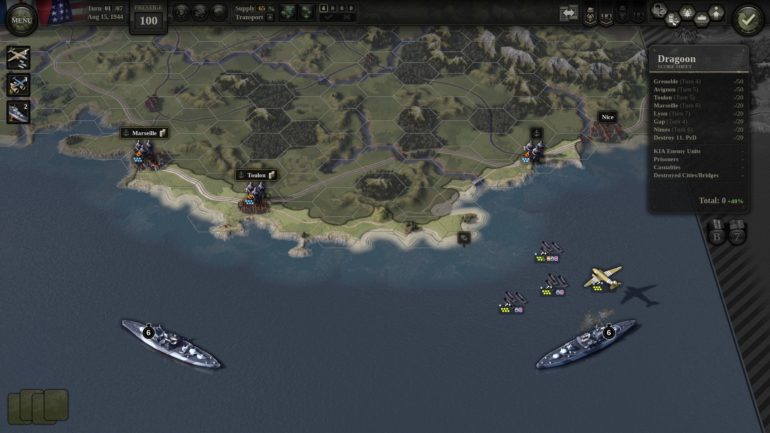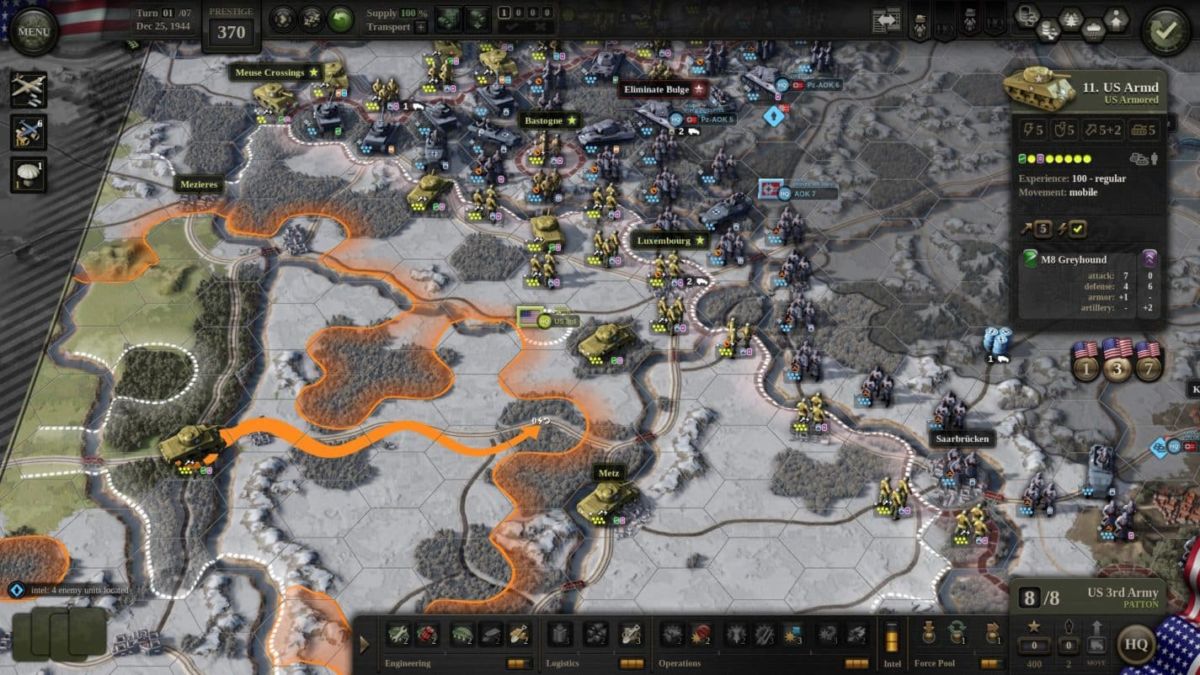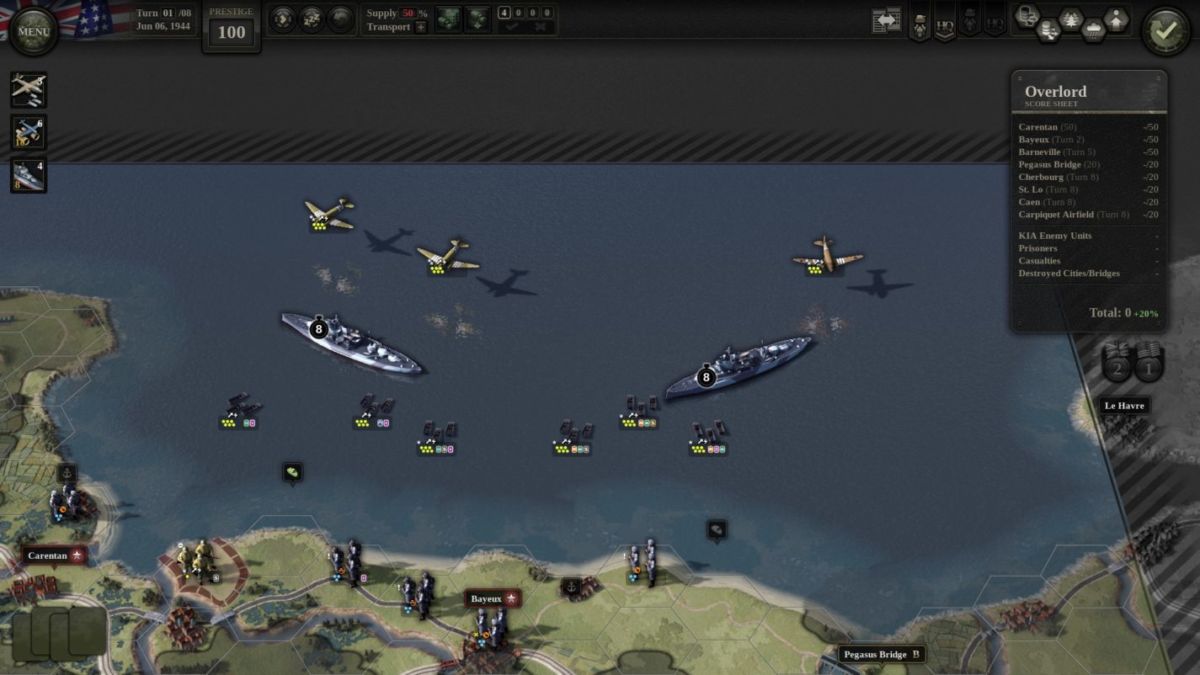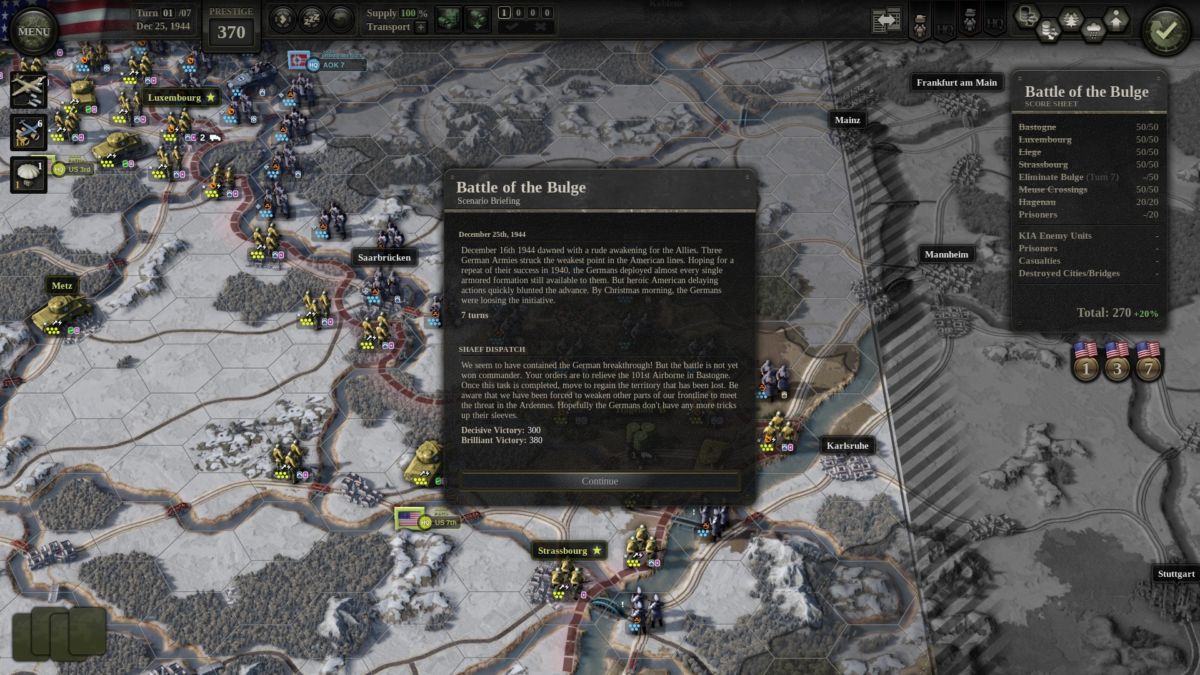The developers at 2×2 and Croteam outdid themselves with their latest installment in the Unity of Command series of games, Unity of Command 2. The goal of the game is for the player to take command of the Allied forces on the Western Front in three distinct theaters through either scenarios or the grand campaign. The focus of Unity of Command 2’s core gameplay loop is on good strategic planning and effective execution of a well thought out plan. This Unity of Command 2 guide will arm players with the core strategic and tactical tips to command their forces to a timely victory.
Spend Prestige Liberally, Especially in Campaigns or Lower Difficulty Playthroughs
Prestige is the main strategic currency in Unity of Command 2 that lets player purchase upgrades for their HQs, choose theater assets to aid in missions, and recruit specialists and other reinforcements to strengthen their troop deployments in each scenario. Depending on how quickly players take their objectives in missions, they will be rewarded with prestige. To maximize prestige gain in scenarios, it is wise to spend a good portion of prestige to strengthen key units that will carry the day.
The Pre-Battle Screen: A Time to Survey Forces and Plan
At the start of a scenario, players will be greeted with a general overview message describing the current situation and a pre-battle screen. In this screen, only HQs and supply depots can be moved around the map. In some missions, in the pre-battle screen, players will have the option to apply free reinforcements or pay prestige to strengthen their deployed troops with specialists. This pre-battle screen is the best opportunity the player will have to survey all available forces, modify them, and then plan their moves. Success in Unity of Command 2 rests on how well players can formulate and commit to a plan.
Use Railways and Roads as Guiding Features for Deciding on the Main Axis of Attack
Supply lines are drawn along railways and supply depots can be placed anywhere where there is a road or railway in Allied territory. It is critical to make sure to have units in supply at all times if possible, as the penalties for being out of supply progressively gets harsher for every turn out of supply. Moreover, the enemy will be using the same roads and railways to draw their own supply lines, meaning that attacking along key railways and roads a player will ensure that their units stay in supply and maintain their momentum, while cutting enemy units off from their supply lines for easy cleanup later.
Apply the Schwerpunkt Doctrine – The Concentrated Attack
In every scenario, players will have a limited number of turns to take their objectives, and thus speed and precision is of the utmost importance. In the original Unity of Command, the main campaign focuses on the Axis perspective on the Stalingrad campaign, with the intent of educating the player in the doctrine of the concentrated attack or schwerpunkt. Unity of Command 2 is no different. The concentrated attack means that when choosing where to attack, players should focus on the weakest point of an enemy frontline and apply maximum force to that weak point to achieve a breakthrough.
Make Critical Moves First
Once a player composes a plan to execute, it’s highly recommended to execute moves and orders that concern the main axis of attack that will decide the success of a mission first before moving on to other less important actions. The reason for this is if something throws a wrench into the plan and there are still unused player units, they can be activated to potentially rectify the situation. If the plan critically fails, especially at the beginning, then it is just as easy to restart the mission and try again.
Use Theater Assets to Aid the Most Crucial Attacks
From either initial scenario conditions or purchased campaign theater assets, players will have access to various strategic abilities, such as bombing runs, deploying new units, and scout planes. These abilities, especially those that directly damage enemy units, like bombing strikes, should be applied at the critical attack to increase the odds of combat success. Depending on the fortification level of the enemy unit being hit with an ability, it might be necessary to hit them with successive strikes.
Infantry Is Numerous
Infantry divisions will be the most common type of unit that players will have access to. These units are not overwhelmingly strong nor particularly fast on the strategic map. However, in most scenarios, infantry is already set up on the enemy frontline and are able to attack right away if the player deems it necessary. It’s recommended to use multiple infantry divisions to attack a single point to create a break in the enemy frontline through which the main attack will be made, as infantry is numerous and mostly expendable.
Armor is the Main Maneuver and Strike Force
The main advantages of armored divisions is their overall combat power, general resilience, and, primarily, their speed. Most scenarios will have large distances between objectives and armor will be perfect for travelling far and quickly to reach distant objectives to capture them in time. Where infantry makes the initial attack on the enemy’s weak point, armor moves through to attack weaker enemy units or cut off the supply of enemy units on the frontline.
Don’t Forget to Use Extended Movement
All units, aside from HQs, have two actions: movement and attack, which can be completed in any order. However, if there is no need to attack with a unit or the goal of the unit is to make as much ground as possible in a turn, players can convert the attack action into an extended move.
For infantry, it will typically give an extra movement point on top of their standard three movement points, whereas for armor it will give an additional three in addition to their five standard movement points. The extended move is especially useful for armor that has broken through the frontline and whose goal is not necessarily to attack but to make ground or cut an enemy supply line or get in range for an attack the following turn.
Artillery is One of the Most Useful Specialist Steps
The artillery specialist step is one of the most common reinforcements found in infantry divisions, as it makes infantry more resilient on the defence if it holds its ground. Artillery, though, has a much greater use than just providing defence. Each Allied HQ has unlockable special abilities for its subordinate divisions, like repairing bridges, making feint attacks, or giving a no retreat order.
One of these abilities is the artillery strike, which is available to all divisions with an artillery specialist. The British HQs start the campaign with this ability unlocked. The artillery strike allows the unit to make a suppressive attack on an adjacent enemy unit, which weakens the target. This makes successive attacks on the weakened unit easier. The artillery strike, unlike the feint attack, causes more suppression and does not cause any suppression to the division itself, except to the artillery specialist, indicating that it has been used.
Aim For Combat Odds of 1:1 or Higher
One of the key puzzle elements to Unity of Command’s strategic gameplay is achieving objectives and causing appropriate damage, while suffering as few casualties as possible. Hence, when attacking enemy divisions, it is best to attack with the odds in your favor. The basic combat odds are 1:1, indicating that the likely outcome of an attack is that the attacker and defender will suffer one hit. Any odds that result in more damage to the attacker should be avoided as it is inefficient, or if necessary use active unit abilities like artillery strike from neighboring units to weaken the target, and then make an attack at better odds.
Keep Track of Friendly Stragglers
Damage to friendly units, unfortunately, is unavoidable. When a division takes damage and loses its steps or hit points, there is a chance that those destroyed steps will be converted to stragglers. The rogue steps cannot be controlled by the player, but will automatically move at the start of the next friendly turn towards their parent HQ. Once stragglers reach their HQ, the game will automatically spend Command Points, which are needed for activating abilities, equal to the number of straggler steps while also reorganizing them.
Within a turn or two, the steps will be placed into a reserve pool of the HQ and can be used to reinforce friendly divisions of the appropriate nation and HQ. In addition, stragglers will vary depending on which division they came from, meaning if an armored division to damage and its stragglers reached their HQ, they will reorganize into armored steps that can reinforce their original unit or some other the player desires.
Some of the coverage you find on Cultured Vultures contains affiliate links, which provide us with small commissions based on purchases made from visiting our site. We cover gaming news, movie reviews, wrestling and much more.














